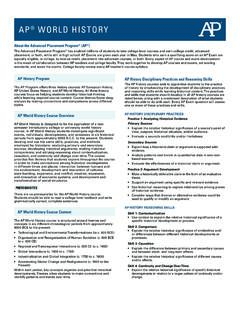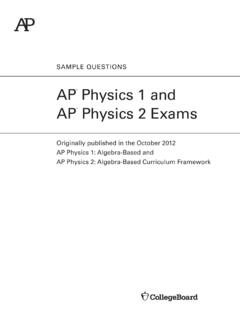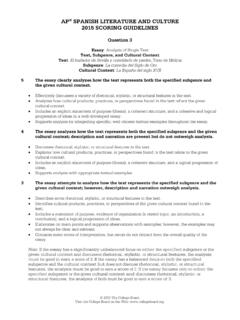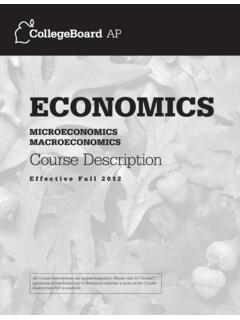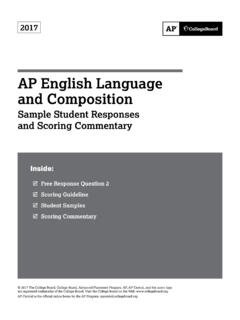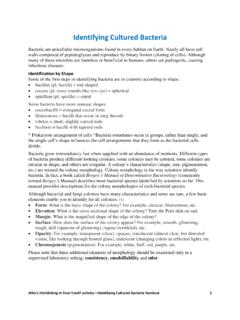Transcription of AP Biology 2016 Free-Response Questions - College Board
1 AP Biology 2016 Free-Response Questions 2016 The College Board . College Board , Advanced Placement Program, AP, AP Central, and the acorn logo are registered trademarks of the College Board . Visit the College Board on the Web: AP Central is the official online home for the AP Program: "1 #*0-0(: '3&& 3&410/4& 26&45*0/4 2016 The College Board . Visit the College Board on the Web: GO ON TO THE NEXT PAGE. -2- Biology Section II 8 Questions Total Time 90 minutes Reading Period 10 minutes Writing Period 80 minutes Directions: Questions 1 and 2 are long Free-Response Questions that require about 22 minutes each to answer and are worth 10 points each.)
2 Questions 3 8 are short Free-Response Questions that require about 6 minutes each to answer. Questions 3 5 are worth 4 points each and Questions 6 8 are worth 3 points each. Read each question carefully and completely. You are advised to spend the 10 -minute reading period planning your answers. You may begin writing your responses before the reading period is over. Write your response in the space provided for each question. Only material written in the space provided will be scored. Answers must be written out in paragraph form. Outlines, bulleted lists, or diagrams alone are not acceptable.
3 Figure 1. Sampling sites of marine mussels at various locations (1 8) in Long Island Sound and the Atlantic Ocean TABLE 1. PERCENT OF INDIVIDUALS POSSESSING lap94 ALLELE Long Island Sound Atlantic Ocean Site12345678lap94 frequency (%) 1316253755595959 SalinityLow HighHigh 1. Leucine aminopeptidases "1 #*0-0(: '3&& 3&410/4& 26&45*0/4 2016 The College Board . Visit the College Board on the Web: GO ON TO THE NEXT PAGE. -3- (LAPs) are found in all living organisms and have been associated with the response of the marine mussel, Mytilus edulis, to changes in salinity.)
4 LAPs are enzymes that remove N-terminal amino acids from proteins and release the free amino acids into the cytosol. To investigate the evolution of LAPs in wild populations of M. edulis, researchers sampled adult mussels from several different locations along a part of the northeast coast of the United States, as shown in Figure 1. The researchers then determined the percent of individuals possessing a particular lap allele, lap94, in mussels from each sample site (table 1). (a) On the axes provided, construct an appropriately labeled bar graph to illustrate the observed frequencies of the lap94 allele in the study populations.
5 (b) Based on the data, describe the most likely effect of salinity on the frequency of the lap94 allele in the marine mussel populations in Long Island Sound. Predict the likely lap94 allele frequency at a sampling site between site 1 and site 2 in Long Island Sound. (c) Describe the most likely effect of LAP94 activity on the osmolarity of the cytosol. Describe the function of LAP94 in maintaining water balance in the mussels living in the Atlantic Ocean. (d) Marine mussel larvae are evenly dispersed throughout the study area by water movement. As larvae mature, they attach to the rocks in the water.
6 Explain the differences in lap94 allele frequency among adult mussel populations at the sample sites despite the dispersal of larvae throughout the entire study area. Predict the likely effect on distribution of mussels in Long Island Sound if the lap94 allele was found in all of the mussels in the population. Justify your prediction. "1 #*0-0(: '3&& 3&410/4& 26&45*0/4 2016 The College Board . Visit the College Board on the Web: GO ON TO THE NEXT PAGE. -4- Figure 1. Bacterial population growth in the presence of two nutrients (nutrient I and nutrient II) 2.)
7 bacteria can be cultured in media with a carefully controlled nutrient composition. The graph above shows the growth of a bacterial population in a medium with limiting amounts of two nutrients, I and II. (a) Estimate the maximum population density in cellsmL for the culture. Using the data, describe what prevents further growth of the bacterial population in the culture. (b) Using the data, calculate the growth rate in cellsmL hour of the bacterial population between hours 2 and 4. (c) Identify the preferred nutrient source of the bacteria in the culture over the course of the experiment.
8 Use the graph to justify your response. Propose ONE advantage of the nutrient preference for an individual bacterium. (d) Describe how nutrient I most likely regulates the genes for metabolism of nutrient I and the genes for metabolism of nutrient II. Provide TWO reasons that the population does not grow between hours 5 and 6. "1 #*0-0(: '3&& 3&410/4& 26&45*0/4 2016 The College Board . Visit the College Board on the Web: GO ON TO THE NEXT PAGE. -5- Figure 1. Percent dry weight of different plant structures during the growing season for an annual plant 3.)
9 The graph above illustrates the percent dry weight of different parts of a particular annual plant (plants that live less than one year) from early May to late August. The percent dry weight can be used to estimate the amount of energy a plant uses to produce its leaves, vegetative buds, stems, roots, and reproductive parts (seeds, receptacles, and flowers). (a) Identify the direct source of the energy used for plant growth during the first week of May, and identify the part of the plant that grew the most during the same period. (b) Based on the data on the graph, estimate the percent of the total energy that the plant has allocated to the growth of leaves on the first day of July.
10 (c) Compared with perennials (plants that live more than two years), annual plants often allocate a much greater percentage of their total energy to growth of their reproductive parts in any given year. Propose ONE evolutionary advantage of the energy allocation strategy in annual plants compared with that in perennial plants. "1 #*0-0(: '3&& 3&410/4& 26&45*0/4 2016 The College Board . Visit the College Board on the Web: GO ON TO THE NEXT PAGE. -6- 4. The figure represents the process of expression of gene X in a eukaryotic cell.(a) The primary transcript in the figure is 15 kilobases (kb) long, but the mature mRNA is 7 kb in the modification that most likely resulted in the 8 kb difference in length of the mature mRNA molecule.)
